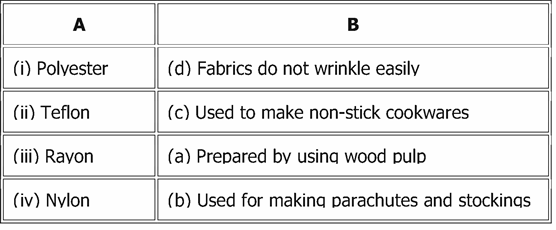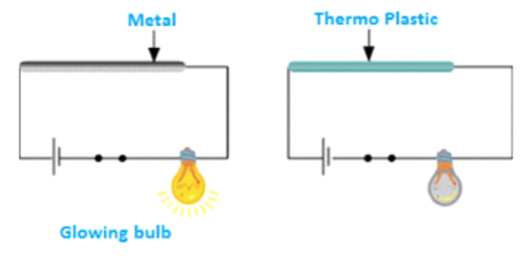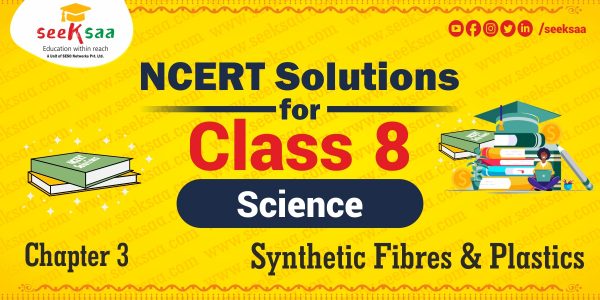| Section Name | Topic Name |
|---|---|
| 3 | Synthetic Fibers and Plastics |
| 3.1 | What are Synthetic Fibers? |
| 3.2 | Types of Synthetic Fibers Rayon |
| 3.3 | Characteristics of Synthetic Fibers |
| 3.4 | Plastics |
| 3.5 | Plastics as Materials of Choice |
| 3.6 | Plastics and the Environment |
Q 1- Explain why some fibres are called synthetic.
Ans- Some fibres are called as synthetic fibres because these are manmade fibers prepared by using chemicals. These are made of small units that join together to form long chains. Some of the examples of synthetic fibres are nylon, rayon, acrylic, polyester etc.
Q 2- Mark the correct answer.
Rayon is different from synthetic fibres because
(a) it has a silk-like appearance.
(b) it is obtained from wood pulp.
(c) its fibres can also be woven like those of natural fibres.
Answer: (b) it is obtained from wood pulp.
Q 3- Fill in the blanks with appropriate words.
(a) Synthetic fibres are also called __________ or __________ fibres.
(b) Synthetic fibres are synthesised from raw material called __________.
(c) Like synthetic fibres, plastic is also a __________
Answer :
(a) Synthetic fibres are also called artificial or manmade fibres.
(b) Synthetic fibres are synthesised from raw material called petrochemicals.
(c) Like synthetic fibres, plastic is also a polymer.
Q 4- Give examples which indicate that nylon fibres are very strong.
Answer :
Following are the examples that indicate nylon fibres are very strong
Parachutes and ropes of rock climbing are made of nylon
Nylon is used in making seat belts, fishing nets and tyre cords.
Nylon is used in making sports accessories like rackets.
Q 5- Explain why plastic containers are favored for storing food.
Answer : Because plastic is non-reactive and will not react with the ingredients of the food items.
Q 6- Explain the difference between thermoplastic and thermosetting plastics.
Answer :
Thermo setting plastic | Thermoplastic |
Cannot be bent, it will break if we attempt to bend thermo setting plastic | Thermoplastic can be bent easily |
On heating thermosetting plastics, it cannot be softened. This is the reason it cannot be reshaped once it is molded. | On heating the thermoplastics, it becomes softened and can be molded and reshaped easily. |
Q 7- Explain why the following are made of thermosetting plastics.
(a) Saucepan handles (b) Electric plugs/switches/plug boards
Answer :
a) Thermosetting plastics are used to make saucepan handles because they are bad conductors of heat and also on heating, these plastics do not get softened.
b) Bakelite is a kind of thermosetting plastic which is a bad conductor of heat and electricity. Because of this property it is used for making electric plugs, switches, plug boards, etc.
Q 8- Categorize the materials of the following products into ‘can be recycled’ and ‘cannot be recycled’.
Telephone instruments, plastic toys, cooker handles, carry bags, ball point pens, plastic bowls, plastic covering on electrical wires, plastic chairs, electrical switches.
Answer :
Can be Recycled | Cannot be recycled |
Plastic chairs | Cooker handles |
Plastic bowls | Electrical switches |
Plastic toys | Telephone |
The plastic covering on electrical wires | |
Carry bags | |
Ballpoint pens |
Q 9- Rana wants to buy shirts for summer. Should he buy cotton shirts or shirts made from synthetic material? Advise Rana, giving your reason.
Answer : Rana should buy a cotton shirt for the summer and not a synthetic shirt. Cotton is a good absorber of water. So it can soak the sweat coming out of the body and expose it to the environment. Thus, it helps in evaporating the sweat and helps in cooling our body.
Q 10- Give examples to show that plastics are non-corrosive in nature.
Answer : Plastics are non-corrosive in nature, they do not react even if they come in contact with strong chemicals. For example, the cleaning chemicals that we use at home are stored in plastic bottles, instead of metal containers.
Q 11- Should the handle and bristles of a tooth brush be made of the same material? Explain your answer.
Answer : The handle and bristle of a toothbrush should not be made of the same material as the handle of the toothbrush should be hard and strong while the bristle should be soft and flexible.
Q 12- ‘Avoid plastics as far as possible’. Comment on this advice.
Answer : We should avoid plastics as far as possible because plastics are non-biodegradable in nature. Once introduced into the environment they cause pollution. If burnt they release poisonous gases and the plastic bags thrown in the garbage dumb are swallowed by animals choke their respiratory system and causes fatalities in animals.
Q 13- Match the terms of column A correctly with the phrases given in column B.
A | B |
(i) Polyester | (a) Prepared by using wood pulp |
(ii) Teflon | (b) Used for making parachutes and stockings |
(iii) Rayon | (c) Used to make non-stick cookwares |
(iv) Nylon | (d) Fabrics do not wrinkle easily |
Answer:-

Q 14- ‘Manufacturing synthetic fibres is actually helping conservation of forests’. Comment.
Answer : The manufacturing of synthetic fibers is helpful in the conservation of forests because if we use natural fibers, the raw materials for them have to be derived from the plants, which require cutting off lots of trees. This proves to be helpful in the conservation of forests.
Q 15- Describe an activity to show that thermoplastic is a poor conductor of electricity
Answer : In order to show that thermoplastic is a poor conductor of electricity, we will design a circuit. For that, we need a bulb, some wires, a battery, a piece of metal and a plastic pipe (as shown in the figure below). After setting the experiment switch on the current, you will observe that the bulb glows in the former case. In the latter case, the bulb does not glow. Hence a plastic pipe (which is a thermoplastic) is shown to be a poor conductor of electricity.

NCERT Solutions for Class 9 Science Chapter 4 Structure of Atom
NCERT Solutions for Class 9 Science Chapter 4 Structure of Atom Topics and Sub Topics in Class 9 Science Chapter 4 Structure of Atom: Structure of Atom Charged Particles in Matter The Structure of an Atom How are Electrons Distributed in Different Orbits (Shells)? Valency Atomic Number and Mass Number
NCERT Solutions for Class 8 Science Chapter 6 Combustion and Flame
NCERT Solutions for Class 8 Science Chapter 6 Combustion and Flame Topics and Sub Topics in Class 8 Science Chapter 6 Materials combustion and flame: Section Name Topic Name 6 Materials combustion and flame 6.1 What is Combustion? 6.2 How Do We Control Fire? 6.3 Types of Combustion 6.4 Flame
NCERT Solutions for Class 8 Science Chapter 5
NCERT Solutions for Class 8 Science Chapter 5 Materials Coal and Petroleum Topics and Sub Topics in Class 8 Science Chapter 5 Materials Coal and Petroleum: Section Name Topic Name 5 Materials Coal and Petroleum 5.1 Coal 5.2 Petroleum 5.3 Natural Gas 5.4 Some Natural Resources are Limited Coal and



